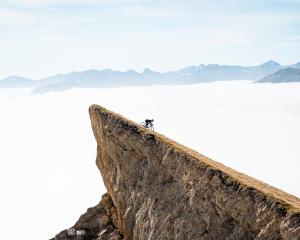It has been a bad few years on the Queenstown Lakes district's roads. The number of crashes has risen sharply, and the driving habits of overseas drivers are increasingly coming under scrutiny.
Guy Williams looks at what could be behind the worrying numbers, and whether the authorities are doing enough to turn them around.
The numbers speak for themselves: since 2012, crashes on Queenstown Lakes district roads have risen by more than a quarter and the involvement of overseas drivers in those crashes has doubled.
Recently updated New Zealand Transport Agency (NZTA) figures for last year reveal what most of the district's residents have been saying for at least the past 12 months: the district's roads are becoming more dangerous.
The 321 crashes on Queenstown Lakes district roads last year was a 22% increase on 2013's figures, and a 27% rise from 2012.
Over the same period, the percentage of crashes in which overseas drivers were implicated has risen from 5.5% to 11%. Eight people died on the district's roads last year - a number equal to the previous four years combined.
Last November, in the worst crash seen in the district for years, three Hong Kong tourists were killed when their rental van was struck by a truck and trailer unit near Luggate.
Police commander for the Otago Lakes-Central area, Inspector Olaf Jensen, says overseas drivers, high visitor numbers and challenging roads and road conditions were the major factors in the Queenstown Lakes district's crash statistics.
A year ago his Queenstown colleague, Senior Sergeant John Fookes, told an inquest that police needed the power to remove drivers they deemed incompetent from the road.
A common factor in crashes and complaints involving overseas drivers, particularly those from China and India, was ''the inability of a proportion of these drivers to have proper control of their hired motor vehicle'', Sen Sgt Fookes said.
Police could only forbid an individual from driving by arresting them for a qualifying offence, such as dangerous driving, and imposing a bail condition.
Asked if he agreed with Snr Sgt Fookes' comments, Insp Jensen would only confirm that current legislation did not allow police to remove incompetent drivers from the road.
Police were working with rental car companies to have rental contracts ''reviewed'' when serious driving issues were identified, he said.
Queenstown Lakes Mayor Vanessa van Uden said the rising number of crashes was a concern, but the figures also showed that nearly 90% of accidents were caused by New Zealand drivers.
''The police tell us that speed, inattention and failure to drive to the conditions are the most common causes of crashes everywhere.''
Efforts to educate overseas visitors needed to continue, but residents needed to ''step up and take responsibility for our own driving behaviour''.
NZTA southern region director Jim Harland said the agency was leading the Visiting Drivers Signature Road Safety Project, a raft of recent measures being introduced by police, ACC, rental vehicle companies, accommodation providers, AA, Tourism New Zealand and local councils.
That ''broad-based approach'' included working through more than 150 ideas provided by members of the public.
Fresh analysis of crash data was under way to find out why the number of crashes was continuing to rise in the district: ''where people have been crashing and why''.
''Is it certain nationalities, is it certain times of the day, is it weather conditions, are the roads contributing to it?''We need to understand that more before we can be definitive about our view.''
There had been an increase in self-drive tourists from emerging markets, such as China and India, who were unfamiliar with the New Zealand roading environment.
''Whether that's the reason for this part of New Zealand and specifically Queenstown, we don't know.''
He had seen data indicating that Queenstown had 130% more visitors than residents during tourism peak times.
''So inevitably if there's a crash, the odds of that having an overseas licence holder involved is much greater.''
The involvement of vehicle rental companies in the Visiting Drivers Signature Road Safety Project showed they were taking a responsible approach to the issue, Mr Harland said.
''They want to ensure their customers come back safe and advise their friends and relatives that New Zealand is a good place to visit.
''It's also important from their business perspective that they have safe customers who bring back their vehicle in one piece.''
Improving driving
Measures to improve driving safety in the Queenstown Lakes district:
• Steering wheel tags with safe driving information placed in rental vehicles.
• Improved signs in high-crash-risk areas.
• Co-operation between police and 14 rental vehicle companies operating in the district; rental contracts cancelled when poor driving is reported.
• Information sharing between rental vehicle companies to prevent drivers whose contract has been cancelled by one company from renting a vehicle from another.
• Creation of a code of conduct - by the Rental Vehicle Association, Tourism New Zealand and Tourism Industry Association - for rental car company and accommodation provider frontline staff, requiring them to ask overseas visitors ''screening questions'' about their driving intentions.
• Fast-tracking of safety improvements on state highways in Otago and Southland, including an additional 50km of centre-line ''rumble strips'', 140km of no-passing markings and 200km of highway marked with ''keep left'' arrows - expected to completed by July 1.
• Tourism New Zealand is creating an updated in-flight video with stronger safety messages for overseas drivers.
Advertisement














